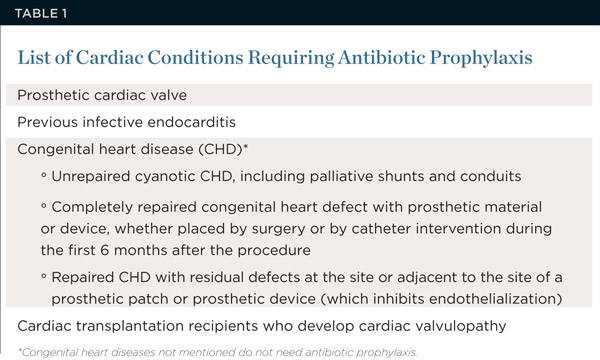Dentists prescribe 10 of all outpatient antibiotic prescriptions writing more than 257 million prescriptions per year. This time period is recommended so that there will be high blood levels of antibiotic.

Take it 30 minutes before the procedure if it is taken parenterally.

Antibiotic prophylaxis dental. Antibiotics of choice for prophylaxis Take one dose of an antibiotic by mouth one hour before certain dental oral or upper respiratory tract procedures. Basing on the available RCTs the use of antibiotic prophylaxis is protective against early implant failures. The scientific rationale for prophylaxis was to eliminate or reduce transient bacteraemia caused by invasive dental procedures.
Antibiotic Prophylaxis for Dental Procedures It has been thought that dental procedures could cause infective endocarditis in patients with underlying cardiac risk factors and that antibiotic. Prophylactic antibiotics are recommended when these patients undergo procedures that are at risk for producing bacteremia. Methods This guideline was originally developed by the Council on Clinical Affairs and adopted in 1990.
Antibiotic prophylaxis has been used in dentistry for patients at risk of infective endocarditis or prosthetic joint infection. Many dentists are confused for indications for antibiotic prophylaxis and rely on the recommendation from practitioners. Antibiotic prophylaxis against infective endocarditis is not recommended for people undergoing dental procedures and subsequently the prescribing of amoxicillin 3 grams the most commonly used drug and dose for prophylaxis was significantly reduced.
In cases where antibiotics are deemed necessary it is most appropriate that the orthopedic surgeon recommend the appropriate antibiotic regimen and when reasonable write the prescription Additional Considerations. Antibiotic prophylaxis should be taken in a single dose 30-60 minutes before dental treatment. Clinicians and researchers are increasingly concerned about the overuse of antibiotics and resulting development of.
Antibiotic prophylaxis is recommended for invasive dental procedures that involve the manipulation of gingival tissue or periapical region or perforation of the mucosa when. 13 Advice on antibiotic prophylaxis. Antibiotic prophylaxis is the use of antibiotics before surgery or a dental procedure to prevent a bacterial infection.
The empiric use of antibiotic prophylaxis for dental procedures especially those that cause bleeding in the mouth has become a reasonably well-established practice among dental professionals. Background of antibiotic prophylaxis for dental procedures For many years it was accepted clinical practice when carrying out dental procedures on patients who were considered to be at risk of developing infective endocarditis IE to administer preventive prophylactic antibiotics beforehand. Prophylactic antibiotics are not recommended prior to dental procedures to prevent prosthetic joint infection.
In fact when you first call to make an appointment at a new dental office the receptionist may ask you if you require premedication prior to dental procedures. However many dentists are confused by the indications for and the nature of antibiotic prophylaxis. Antibiotic prophylaxis is recommended with certain dental procedures 346818 but this should be directed against the most likely infecting organism.
This guideline is intended to help practitioners make decisions regarding antibiotic prophylaxis for dental patients at risk. 20 rows Antibiotic Prophylaxis Against Infective Endocarditis was developed to address. Many are for prophylaxis in patients with prosthetic joint replacements.
Amoxicillin is the drug of choice for prophylaxis. The American Dental Society states that in general prophylactic antibiotics are not recommended to prevent prosthetic joint infections. Lewis and Grant hypothesized that surgical procedures provided microorganisms with access to the systemic circulation that would result in endocardins.
When procedures involve infected tissues or are performed on a patient with a compromised host response additional doses or a prescribed pre- and postoperative regimen of antibiotics may be necessary. Prior to your scheduled dental treatment your dentist or healthcare provider may recommend antibiotic prophylaxis also known as dental premedication to you. This practice isnt as widespread as it was even 10.
A second dose is not necessary. Whenever an antibiotic prophylaxis is needed there is still insufficient evidence to confidently recommend a specific dosage. If a patient with an indication for prophylaxis who appropriately received antibiotic premedication prior to a dental procedure one day and who is then scheduled the following day for a dental procedure also warranting premedication eg dental prophylaxis the antibiotic prophylaxis regimen should be repeated prior to the second appointment.
